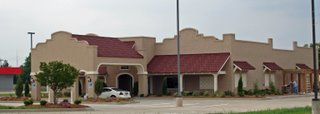This is a long post, but important. Bear with it and realize this is a game stopper. This was another email that I bounced off a couple folks and then decided to publish in its entirety.PRMC has to install new portable telemetry monitors. When the employees ask, no one seems to know what kind of heart monitors the hospital has bought, nor when they are going to be installed, or where they're going to install them. Rumors abound, of course, but no one seems to actually know.

Of course, biomed and the former assistant CNO and director of goodness knows how many departments went somewhere to learn about the monitors, but, of course, one of those two people has now left PRMC.
The general plan seems to be to install these monitors that only one person in biomed knows how to work on (which is also something that currently happens, even with a system that's been installed for quite some time), remove the telemetry technician from ICU, and consolidate all telemetry monitoring in one place with two telemetry techs. Currently, ICU has a telemetry tech to watch only the ICU patients, and the other telemetry tech monitors all other telemetry monitors throughout the hospital (excluding the emergency room), as well as the cameras for the stepdown beds.
IF all of the portable monitors were all present, this would have the hospital telemetry technician watching approximately 55 heart rhythms, 13 cameras, and the 13 stepdown monitor's blood pressure and oxygen saturation readings. (But about 20 portable units have gone missing.) This is, of course, too much, so it would SEEM to make sense to combine the ICU telemetry and all other hospital telemetry and split the number of monitors between two technicians. The problems that this consolidation would create are actually numerous, and affect patient care.
At this point in time, the hospital has already acknowledge that there is a large communication problem that affects the efficacy of the hospital telemetry tech. The

hospital telemetry tech sits in a small room (affectionately termed "the hole") and has the un-enviable task of sitting in a chair for 12 hours, begging the 3rd floor or ICU nurses for breaks, and having no way of effectively communicating with any other floor than 3A. Of course, currently, the only other floor that is allowed telemetry monitoring is 7A, as telemetry overflow. This is exists for a couple of reasons. 6th floor doesn't monitor telemetry because there's been something wrong with the telemetry system for that floor every since it was installed on the re-model. 4th floor doesn't monitor telemetry for a reason that the telemetry techs were never told of, but it may have something to do with a delayed Code Blue on a patient due to poor communication between telemetry and the other hospital floors.
The OTHER reason that telemetry

monitoring has been reduced to only 3A and 7A is because there is a serious lack of nurses who actually know how to read a heart rhythm. Apparently, this is not a requirement of nurses who have to take telemetry patients. It is not an uncommon occurence for 7A to have no one who knows how to read telemetry, and only one or two nurses on 3A (the cardiac floor) who know how to read it. Add to all of this, the fact that the currently telemetry tech staff (both hospital and ICU) have very little training beyond the heart rhythms themselves. The telemetry techs are all perfectly capable of reading the heart rhythms, and identifying problems, but they have very little idea of what to tell a nurse is the biological reason behind a reported change.
So, the telemetry tech doesn't know, the nurse doesn't know, so somebody needs to pray that there's an experienced cardiac nurse to ask readily available. If the nurse doesn't understand that there is an importance behind the telemetry changes reported to them, then they are unlikely to follow an appropriate course of action. And, quite frankly, there are few of the staff nurses left who are going to take the time to search out someone who would know what to do.
Also, the proposed change would lead to problems for ICU and the patients there. The ICU telemetry tech would no longer be "on-site" with the patients. The ICU tech monitors rhythm, blood pressure, and oxygen saturation on all the ICU patients, but there are also other invasive lines/readings to monitor, such as arterial lines and Swan-Ganz readings. The hospital telemetry tech has never monitored these, except for a few arterial lines that are quickly discontinued on stepdown, and has no training on what they do and/or should read. Also, except for a few stable or non-titrated (which mean the medicine is not supposed to be increased or decreased), the hospital telemetry technician has very little experience with the common IV drips used in ICU. Dopamine affects blood pressure and heart rate, Cordarone affects rhythm, Cardizen affects rhythm, Natrecor is for CHF but can have a bad blood pressure side effect, and Nipride affects blood pressure. These are the most commond drips used, and if the person monitoring the patient doesn't know what they are, what to watch for, and what they do, the patient isn't being monitored properly.
If the ICU telemetry tech is removed from the ICU setting, then they will more than likely be unaware of what drips the patient is on, or how they are being titrated, so they will not know what to look for. The ICU nurses monitor their patients very closely, but they do have at least 2 patients usually. As happened when the telemetry was combined before, no one calls the techs to tell them about admits,

drips, or patient changes. And how is the tech going to contact them in an emergency? Usually the nurses are on top of the situation, and gathered in the patient's room. So, that leaves the tech on the phone, no one answering it, and the tech having no clue if the nurses are in the room.
It's not a good move for the patients, it's been tried before, and failed before. If the problem is that the hospital telemetry technician is watching too many monitors, then, why not, when installing the new system, portion some into the ICU where they can be watched by that technician. Something like, ICU would watch ICU and 7th floor, and the hospital tech would watch 7A. Maybe not very cost effective, maybe not even feasable, but better for patient care than effectively ham-stringing the techs.















